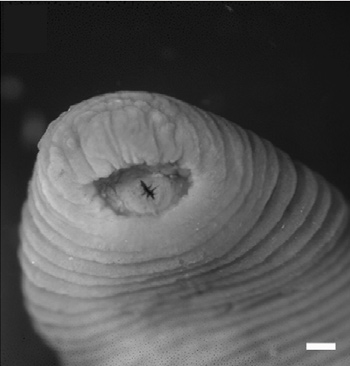T. Rex of Leeches Has Enormous Teeth

A new T. rex of the leech world has been named — one with ferociously large teeth, but only a tiny body and just one jaw.
This new leech species, Tyrannobdella rex, which means "tyrant leech king," was first discovered three years ago in the nostril of a 9-year-old girl by Peruvian physician Renzo Arauco-Brown. The child frequently bathed in lakes, rivers and streams in the Amazonian part of Peru and had felt a sliding sensation in the back of her nose.
Two earlier cases from 1997 were re-discovered from different clinics in the western Amazon.
Eight teeth line this bloodsucker's jaw.
"We named it Tyrannobdella rex because of its enormous teeth," said researcher Mark Siddall, curator in the division of invertebrate zoology at the American Museum of Natural History in New York.
Although its teeth only reach up to 130 microns high — a little more than the width of a human hair — "that's at least five times as high as that of other leeches," Siddall said. "And every one of the people who were found with these in the clinical cases had a frontal headache. Their teeth are big, and these things hurt."
Still, its other physical traits belie its majestic name. The leech is less than two inches long (5 centimeters), and it possesses extremely small genitalia.
Sign up for the Live Science daily newsletter now
Get the world’s most fascinating discoveries delivered straight to your inbox.
"The width of the adult leech is about 1 centimeter, or about the width of my pinkie, while the genitalia are about one-tenth to one-fifth the width of a millimeter, or 100 to 200 microns," Siddall explained. "The diameter of a blood cell is only about seven microns."
Unlike any other known leech, this new species has just one jaw. "It uses it like a saw," Siddall told LiveScience. "It doesn't need a huge wound, because it has incredible suction power to get blood."
World famous, with ancient history
Unlike many leeches, which latch onto bodies from the outside, this new T. rex has the unnerving tendency to seek out the insides of a victim.
Genetic analysis suggests this leech is closely related to a Mexican bloodsucker, Pintobdella chiapasensis, which infests the mouths of tapirs and cows, as well as others in India and Taiwan, such as Dinobdella ferox, a terrible, ferocious leech well-known for feeding on mucus membranes and getting into various human orifices.
All of these species, and others from Mexico, Africa and the Middle East, make up the family Praobdellidae, a group of leeches that seems to attack mammalian body openings. Until now, such behavior has been regarded only as a loathsome oddity instead of a unifying character, since there had not been any data suggesting a close relationship for such geographically disparate species.
The fact that these leeches share family bonds while living distant from one another suggests their common ancestor must have lived when the continents were all pressed together into a single landmass before the supercontinent of Pangaea broke up, the researchers say.
"The earliest species in this family of these leeches no-doubt shared an environment with dinosaurs about 200 million years ago when some ancestor of our T. rex may have been up that other T. rex's nose," Siddall said.
The regular host of this new T. rex remains unknown.
"We think the leech could feed on aquatic mammals, from their noses and mouths for example, where they could stay for weeks at a time," said researcher Anna Phillips, a graduate student affiliated with the American Museum of Natural History.
Other leeches, other T. rexes
Besides this new leech, a number of other species share the abbreviated name T. rex — in addition to the legendary carnivorous dinosaur, an ant living in Malaysia, a mole rat found only on Mt. Kenya, an extinct snail and extinct scarab beetle also bear this formidable sobriquet.
However, this new T. rex is not enough for the researchers. There are 600 to 700 species of leeches that science has described so far, but Siddall and his colleagues suspect there could be as many as 10,000 species throughout the world.
"Last week we were up to our necks in water in Peru trying to find more," Siddall said.
The scientists detailed their findings online April 14 in the journal PLoS ONE.
- 10 Amazing Things You Didn't Know About Animals
- Rumor or Reality: The Creatures of Cryptozoology
- The World's Ugliest Animals
Editor's Note: The story has been corrected to state that the width of the adult leech is about 1 centimeter, not 1 millimeter.










